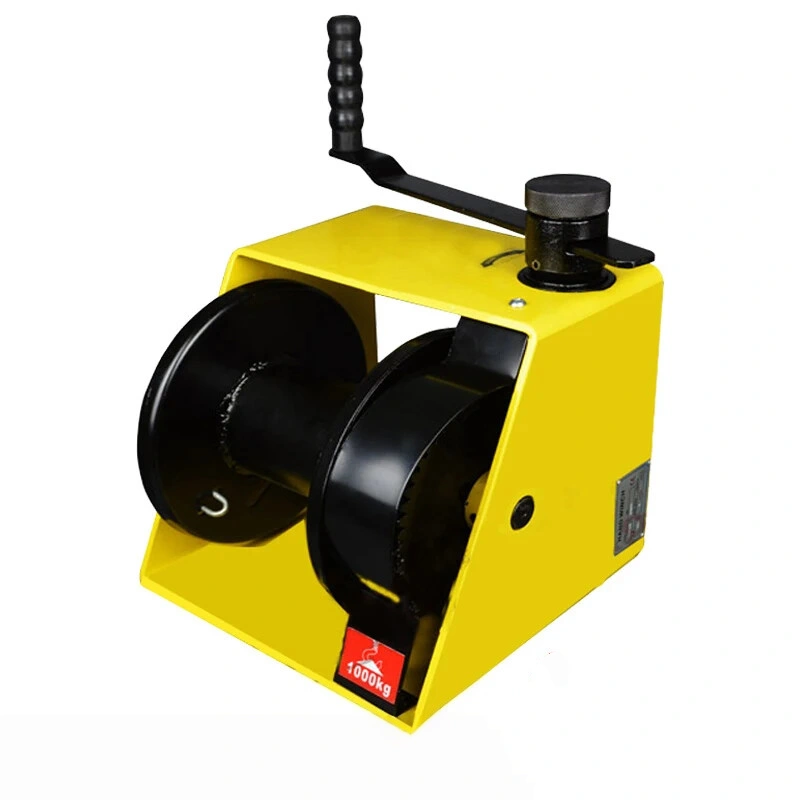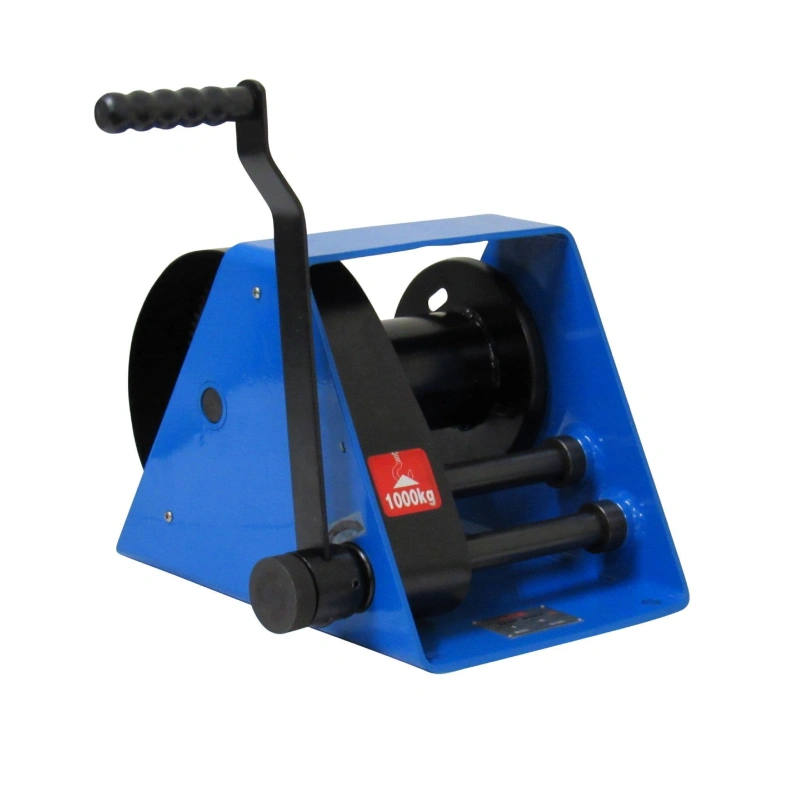When you compare the toe jack vs the bottle jack, you find that each hydraulic jack serves a unique purpose. You use a toe jack for lifting heavy machinery in tight spaces, while a bottle jack works best for vehicle or general lifting with more clearance.
Choosing the right hydraulic jack keeps your lifting tasks safe and efficient. Powerful Machinery provides high-quality hydraulic lifting technology for industrial and professional lifting. Use this guide to match the perfect jack to your specific lifting needs.
Key Takeaways
Toe jacks excel in tight spaces, making them ideal for heavy machinery with low ground clearance.
Bottle jacks provide higher vertical lift, perfect for vehicles and construction tasks requiring more clearance.
Always match the jack type to your lifting needs to ensure safety and efficiency during operations.
Regular maintenance of your jack, including inspections and lubrication, is crucial for safe and reliable performance.
Follow strict safety protocols, such as using jack stands and never exceeding weight limits, to prevent accidents.
Toe Jack vs Bottle Jack Quick Comparison
Key Features Overview
When you compare the toe jack vs the bottle jack, you see clear differences in design, lifting capacity, and range of motion. You need to know these features before you choose the right jack for your job. The table below helps you understand how the toe jack vs the bottle jack stack up against each other.
Feature | Toe Jack | Bottle Jack |
|---|---|---|
Design and Size | Compact, fits into tight spaces | Bulkier, cylindrical shape |
Lifting Capacity | Ranges from 2 tons to 50 tons | Typically up to 20 tons |
Range of Motion | Limited vertical range, more horizontal movement | Higher vertical range, extends further |
Ideal Use Cases | Heavy machinery, confined spaces | Vehicles, general lifting, construction |
You notice that the toe jack vs the bottle jack differ most in lifting capacity and where you use them. Toe jacks give you more options for lifting heavy loads in tight areas. Bottle jacks work better when you need a higher vertical lift, such as raising vehicles or supporting beams.
Modern hydraulic jacks now offer smart technology, eco-friendly fluids, and lightweight materials. You benefit from enhanced safety features like automatic locking and overload protection. These advancements make the toe jack vs the bottle jack safer and easier to use in industrial settings.
Pros and Cons Snapshot
Here is a quick look at the pros and cons of toe jack vs bottle jack. This helps you decide which jack fits your lifting needs.
Toe Jack Pros:
Fits under low-clearance equipment
Handles high lifting capacity for heavy machinery
Compact and portable for tight spaces
Precise control for leveling tasks
Toe Jack Cons:
Limited vertical range
Best for specific industrial uses
Bottle Jack Pros:
Offers higher vertical lifting capacity
Simple operation for vehicles and general tasks
Sturdy and reliable for construction
Bottle Jack Cons:
Bulkier design limits use in confined spaces
Lower lifting capacity compared to some toe jacks
When you compare the toe jack vs the bottle jack, you see that each jack has strengths for different lifting capacity needs. You should match the jack to your task for safe and efficient lifting.
What is a Toe Jack?
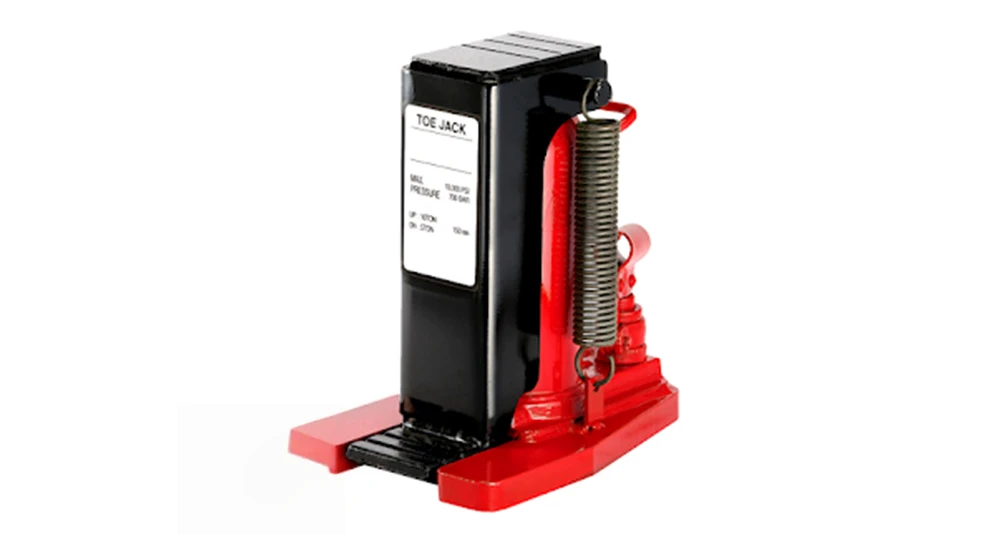
Design and Function
A toe jack is a hydraulic lifting tool that helps you move heavy equipment in places where other jacks cannot fit. You use it when you need to lift loads with very low ground clearance. The toe jack slides its lifting arm, called the “toe,” under machinery or objects with as little as 15-25 mm of space.
Powerful Machinery’s toe jack stands out with its ultra-low clearance operation, making it perfect for tight spots. You get exceptional load capacity, ranging from 3 to 100 tons, so you can handle even the heaviest tasks.
The jack uses fine-tuned hydraulic controls, giving you slow and even lifting for safe and balanced movement. Its wide base and sturdy build help distribute force, reducing the risk of slipping. You also benefit from a compact design with handles and wheels, making it easy to move and set up for any application.
Industrial Lifting Applications
Toe jacks play a key role in many industries. You find them in construction, manufacturing, automotive, railway, and mining. Each application requires a reliable lifting solution for heavy loads in confined spaces. The table below shows where you might use a toe jack for your next application:
Sector | Description |
|---|---|
Construction | Largest application segment, essential for moving and positioning heavy components in confined spaces. |
Manufacturing | Used for equipment installation and maintenance, enhancing operational efficiency in modern processes. |
Automotive | Important for vehicle maintenance and assembly, especially with the rise of electric vehicles. |
Railway | Utilized for track maintenance and rolling stock repairs, requiring durable lifting solutions. |
Mining | Relies on toe jacks for equipment maintenance and material handling in challenging environments. |
You see that each application benefits from the toe jack’s ability to lift and position heavy items where space is limited.
Advantages of Powerful Machinery Toe Jack
When you choose a Powerful Machinery toe jack, you get more than just a lifting tool. You gain a solution designed for safety, precision, and ease of use in every application. Here are some unique features:
Ultra-low clearance operation for tight spaces
Exceptional load capacity for any application
Precision hydraulic controls for safe lifting
Wide base for stability in every application
Compact, portable design for easy transport
360° rotatable handles and dual-piston systems for better efficiency
You can trust Powerful Machinery to deliver a toe jack that meets the demands of any application, whether you work in construction, manufacturing, or another industry.
What is a Bottle Jack?
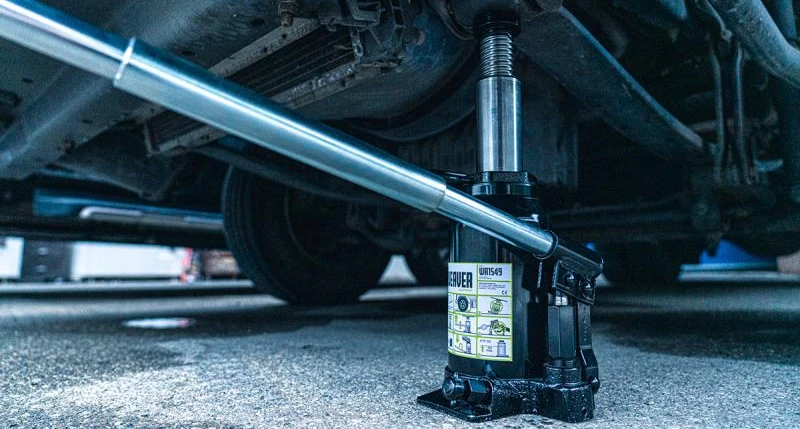
Bottle Jack Design
You see a bottle jack in many workshops and construction sites. This tool has a vertical hydraulic cylinder shaped like a bottle. You use a bottle jack to lift heavy loads with a simple pumping action. The jack uses two pistons connected by a hydraulic fluid chamber.
When you pump the handle, you apply force to the smaller piston. This force creates pressure in the fluid, which pushes up the larger piston. You get a powerful lift with minimal effort. The compact design lets you store the bottle jack easily.
You find models with lifting capacities from 2 tons to 20 tons for standard use, and some industrial bottle jack models can lift to 100 tons. The bottle jack stands out for its high weight capacity and reliability in heavy-duty tasks.
You rely on the bottle jack for vertical lifting, which is perfect for raising construction beams, machinery, or vehicles.
Tip: Always check the base of your bottle jack before use. A large, heavy-duty iron base gives you better stability and safety.
Common Lifting Uses
You use a bottle jack for many lifting tasks. In automotive repair, you lift vehicles for maintenance or tire changes. On construction sites, you raise concrete pillars or support beams. You also use a bottle jack in restoration projects, such as lifting classic cars in garages.
The bottle jack is essential for roadside assistance when you need to change a flat tire. You depend on the bottle jack for safe and efficient lifting in these situations.
Vehicle maintenance and repair
Roadside assistance
Construction site lifting
Garage restoration projects
You must inspect your bottle jack before each use. Proper training helps you avoid accidents. Always use two forms of support when lifting vehicles to prevent slips and injuries.
Toe Jack vs Bottle Jack: Head-to-Head
Design Comparison
When you look at the design of a toe jack and a bottle jack, you notice clear differences. A toe jack has a low-profile toe that slides under equipment with very little ground clearance. You use this design when you need to start lifting from a minimum height.
The toe jack’s base sits flat and wide, which helps you keep the jack stable during lifting. Powerful Machinery’s toe jack uses a durable carbon steel base and a chrome-plated plunger. This design gives you strength and corrosion resistance for industrial lifting.
A bottle jack stands upright with a cylindrical body. You use it when you have more space under the load. The bottle jack’s vertical piston gives you a higher lift height, but you need more clearance to fit the jack under your equipment.
The base is usually smaller than a toe jack, so you must place it carefully for safe lifting. You find bottle jacks in automotive shops and construction sites where you need to raise vehicles or beams.
Tip: Choose a toe jack when you need to lift heavy machinery from a minimum height. Pick a bottle jack when you need a higher lift height and have enough clearance.
Lifting Capacity
You want to know how much weight each jack can handle. Toe jacks and bottle jacks both offer strong lifting power, but their capacities depend on the model and application.
For example, the VEVOR Hydraulic Toe Jack can lift to 5 tons on the top and 2.5 tons on the toe. Powerful Machinery’s toe jack models give you a wide range of lifting capacities, from 3 tons up to 100 tons. You can choose the right model for your lifting needs, whether you work in a small workshop or a large industrial plant.
Bottle jacks also come in many sizes. Standard models lift from 2 tons to 20 tons, but some heavy-duty bottle jacks can handle even more. You often use a bottle jack for lifting cars, trucks, or construction materials.
The vertical design lets you reach a higher lift height, but you must check the minimum height before you start lifting. Always match the lifting capacity of your jack to the weight of your load. Never exceed the rated capacity, as this can cause accidents.
Range of Motion
You need to consider the range of motion when you choose between a toe jack and a bottle jack. A toe jack gives you precise control for lifting heavy loads in tight spaces. The toe slides under equipment with a very low minimum height, sometimes as little as 15 mm.
You can start lifting from almost ground level. The range of motion is more horizontal, which helps you move or level machinery with accuracy. The lift height is usually shorter, but you get better control for delicate tasks.
A bottle jack gives you a greater vertical lift height. You use it when you need to raise a load much higher off the ground. The minimum height is higher than a toe jack, so you need more clearance to fit the jack under your load.
Once in place, you can extend the piston to reach a tall lift height, which is useful for changing tires or supporting beams. Always check the minimum height and maximum lift height before you begin lifting.
Jack Type | Minimum Height | Maximum Lift Height | Range of Motion |
|---|---|---|---|
Toe Jack | 15-25 mm | 110-150 mm | Low, precise, horizontal |
Bottle Jack | 90-245 mm | 350-450 mm | High, vertical |
Stability and Portability
Stability is important for safe lifting. Toe jacks have a wide, flat base that keeps the jack steady during lifting. You can use them on uneven floors or in tight spaces. The design helps prevent tipping, even when you lift heavy machinery.
Powerful Machinery’s toe jack includes dual strain control for extra safety. You get peace of mind when you lift valuable equipment.
Bottle jacks have a smaller base, so you must place them on a flat, solid surface. They work best when you have enough room to position the jack correctly. The vertical design can make them less stable if the ground is uneven. You should always use extra support, like jack stands, when lifting vehicles.
Portability matters when you move your jack from one job to another. Toe jacks are compact and easy to carry. You can fit them into tight spots and transport them with handles or wheels. Bottle jacks are heavier and bulkier, but you can still move them with a handle.
Both types require regular maintenance to keep them working safely.
To maintain your toe jack, you should:
Store the jack upright in a dry, non-corrosive place.
Lubricate the guides and grease the lifting piston regularly.
Remove the slider for cleaning and maintenance.
Pump the lifting piston to the right height before greasing.
Clean the air vent screw with compressed air.
Change the oil once a year, following the steps in the manual.
You keep your lifting equipment in top shape by following these steps. Regular care ensures safe lifting and extends the life of your jack.
Note: Always inspect your jack before each use. Check for leaks, cracks, or worn parts to avoid accidents during lifting.
Choosing the Right Jack for Lifting
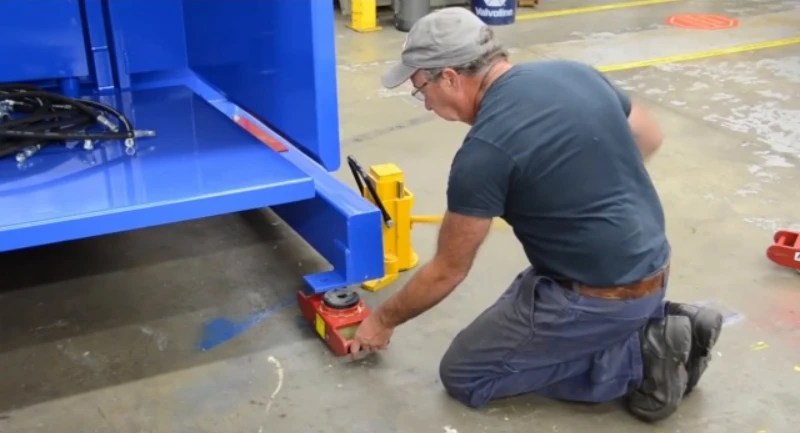
Decision Guide by Use Case
You want to select the right hydraulic jack for your lifting tasks. Start with a clear load assessment. Know the weight and shape of the object you plan to lift. This step helps you avoid overloading your equipment and keeps your lifting procedure safe.
Next, match your lifting needs to the jack’s design. Each jack type serves a specific purpose. Toe jacks work best when you need to lift heavy machinery in tight spaces.
Bottle jacks give you more vertical lift and work well on flat, open surfaces. If you choose the wrong jack, you risk safety hazards or damage to your equipment. Many people make this mistake by not considering the unique strengths of each jack.
The table below helps you compare the main characteristics and applications of toe jacks and bottle jacks:
Jack Type | Characteristics | Applications |
|---|---|---|
Bottle Jack | Compact, powerful, vertical lifting design | Ideal for trucks, SUVs, and industrial |
Toe Jack | Low-profile base, lifts from the base or ‘toe’ | Used in industrial settings, tight spaces |
You should also consider the environment. If you work in a confined area, a toe jack gives you the flexibility to fit under low-clearance equipment. If you need to raise a vehicle or support a beam, a bottle jack provides the vertical range you need. Always check the lifting capacity and make sure it matches your load assessment.
Powerful Machinery offers certified lifting solutions that meet global safety standards. You can trust their products for reliability and performance in any lifting procedure.
Their toe jacks and other lifting equipment undergo strict pre-operation inspections and quality checks. This commitment to global safety standards ensures you get the safest and most efficient tools for your job.
Tip: Always review the lifting procedure before starting. Make sure you understand the steps and have the right equipment for the task.
Safety Tips
You must follow strict safety protocols when using hydraulic jacks. These steps protect you, your team, and your equipment. Start every lifting procedure with a thorough pre-operation inspection.
Check the jack for leaks, cracks, or worn parts. Inspect hydraulic cylinders and valves. Make sure the hydraulic fluid level is correct. Lubricate moving parts to reduce wear.
Before you begin lifting, place the jack on a solid, level surface. Never exceed the jack’s weight capacity. Overloading can cause catastrophic failures. Always use jack stands to support the load. Never rely on the jack alone. Use the same type of hydraulic jack if you need to lift the same equipment at multiple points.
Wear the right personal protective equipment. Safety glasses protect your eyes from debris and hydraulic fluid. Heavy-duty gloves give you a secure grip and protect your hands. Steel-toed boots keep your feet safe from falling objects.
Follow these safety protocols during every lifting procedure:
Never walk or crawl under a load supported only by a hydraulic jack.
Always use jack stands or other solid supports.
Handle the jack with care. Do not misuse release valves or locking mechanisms.
Lift loads only from designated jack points.
Make sure the jack saddle is in full contact with the load.
Clean the jack before use and check for damage.
Familiarize yourself with the safety features of the hydraulic pump.
Avoid placing any part of your body under the jack without solid support.
Ensure the jack is stable before starting the lift.
After lifting, lower the load slowly and with a controlled descent. This step prevents sudden drops and keeps the lifting area safe. Inspect the jack again after use. Store it in a dry, clean place to maintain performance and safety.
Powerful Machinery designs all lifting equipment to meet or exceed global safety standards. Their products help you complete every lifting procedure with confidence. You can rely on their expertise and commitment to safety for every project.
Note: Following safety protocols and using certified equipment reduces risks and helps you meet global safety standards in every lifting operation.
Are Toe Jacks and Bottle Jacks Interchangeable?
Risks of Incorrect Use
You might wonder if you can use a toe jack and a bottle jack for the same lifting jobs. These two tools look similar, but they serve different purposes. A toe jack works best for lifting heavy machinery in tight spaces.
A bottle jack is designed for lifting vehicles or objects with more clearance. If you use the wrong jack, you risk damaging your equipment or causing an accident.
Incorrect lifting can lead to unstable loads. A bottle jack may not fit under low-clearance machinery. If you force it, the jack could slip or tip over. A toe jack does not provide enough vertical lift for some vehicle tasks. Using the wrong jack can cause the load to shift or fall.
You could injure yourself or others. Equipment damage is another risk. Hydraulic systems can fail if overloaded or misused. You must always match the jack to the lifting job.
Note: Never use a jack outside its rated lifting capacity or intended application. This mistake can result in serious injury or equipment failure.
Expert Recommendations
You should always choose the right jack for your lifting needs. Start by checking the clearance under the object. If you need to lift something with very little space, select a toe jack.
For higher vertical lifting, pick a bottle jack. Review the weight of the load before you begin. Make sure the jack’s lifting capacity matches your requirements.
Follow these steps for safe lifting:
Inspect the jack for damage before each use.
Place the jack on a stable, level surface.
Use jack stands or supports for extra safety.
Never exceed the rated lifting capacity.
Read the manufacturer’s instructions for proper lifting technique.
The table below helps you decide which jack to use for different lifting tasks:
Lifting Task | Best Jack Type | Reason |
|---|---|---|
Machinery in tight spaces | Toe Jack | Fits under low-clearance equipment |
Vehicle or beam lifting | Bottle Jack | Provides higher vertical lift |
You can trust Powerful Machinery for certified lifting solutions. Their products meet strict safety standards. You get reliable performance for every lifting job. Always use the right jack and follow safety guidelines to protect yourself and your equipment.
Conclusion
You now understand that toe jacks excel in tight spaces for heavy machinery, while bottle jacks provide higher vertical lift for vehicles and construction. Matching the right jack to your lifting task keeps your work safe and efficient.
Powerful Machinery stands out by ensuring safety and reliability through regular servicing and dynamic load testing:
Practice | Description |
|---|---|
Regular Servicing | Involves thorough inspections for wear, damage, and misalignment, ensuring hydraulic seals and fluids are maintained. |
Dynamic Load Testing | Tests jacks under simulated real-world conditions to assess their performance and identify potential failures. |
All lifting products meet strict standards like ASME B30.1 and ANSI Safety Standards. You benefit from a five-year warranty on ECO-Jack toe jacks with annual inspections.
Customers rate Powerful Machinery 4.8 out of 5 for fast delivery and custom lifting solutions. For expert advice and certified lifting equipment, trust Powerful Machinery.
FAQ
What is the main difference between a toe jack and a bottle jack?
You use a toe jack for lifting heavy machinery in tight spaces. You use a bottle jack for lifting vehicles or objects with more clearance. Each jack serves a unique purpose.
Can you use a toe jack to lift a car?
You should not use a toe jack for most cars. Toe jacks work best for machinery with low ground clearance. For cars, you get better results with a bottle jack.
How do you maintain a hydraulic toe jack?
You clean the jack after each use. You check for leaks and lubricate moving parts. You store the jack in a dry place. Regular maintenance keeps your jack safe and reliable.
What safety steps should you follow when using hydraulic jacks?
You inspect the jack before use. You place it on a flat, stable surface. You never exceed the weight limit. You always use jack stands for extra support. Safety comes first.
Where can you buy certified toe jacks for industrial use?
You can buy certified toe jacks from Powerful Machinery. Visit Powerful Machinery’s website for high-quality, reliable lifting solutions trusted by professionals worldwide.

